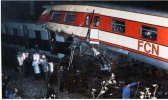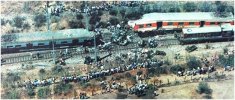CL_TrainDriver
New Member
Hi all!
I am Train Driver from Chile, a country in South America. I appreciate the opportunity to participate in this forum, the truth is that the "English Railways" have always been an inspiration for me, their systems, the incredible variety of types of trains, and their beautiful landscapes. I hope to be able to travel soon, when the pandemic ends.
And it is also because Chile, when the construction of its railroad began, had engineers of English nationality in charge, therefore we have a lot in common. Our first "traindrivers" were English, who over time were nationalizing Chileans. Our first electrical mobilization systems were of English origin, where we used "bastones" or as they are known in the UK "tokens", wich were taken from the "staff". Historically we have never had trains of English origin. But we do have trains with English components, like GEC Traction (and its beautiful engine sounds).
Unfortunately little, and honestly nothing, remains of those systems in operation. Only ruins and memories of what was the "time of glory" of the railroad in my country, which occurred between the years 1920 and 1979 approximately. After that, until 15 years ago, the train only remained and worked with what was available, until the reform began.
Today the railroad is growing again in my country, retaking its ground and gaining strength. And this is what I want to share with you, a bit of the present and over time, I will upload small pieces of the past.
First, some videos that i upload:
Thank you very much!.
I am Train Driver from Chile, a country in South America. I appreciate the opportunity to participate in this forum, the truth is that the "English Railways" have always been an inspiration for me, their systems, the incredible variety of types of trains, and their beautiful landscapes. I hope to be able to travel soon, when the pandemic ends.
And it is also because Chile, when the construction of its railroad began, had engineers of English nationality in charge, therefore we have a lot in common. Our first "traindrivers" were English, who over time were nationalizing Chileans. Our first electrical mobilization systems were of English origin, where we used "bastones" or as they are known in the UK "tokens", wich were taken from the "staff". Historically we have never had trains of English origin. But we do have trains with English components, like GEC Traction (and its beautiful engine sounds).
Unfortunately little, and honestly nothing, remains of those systems in operation. Only ruins and memories of what was the "time of glory" of the railroad in my country, which occurred between the years 1920 and 1979 approximately. After that, until 15 years ago, the train only remained and worked with what was available, until the reform began.
Today the railroad is growing again in my country, retaking its ground and gaining strength. And this is what I want to share with you, a bit of the present and over time, I will upload small pieces of the past.
First, some videos that i upload:
- These are the "Automotores AES" or AES EMU for you. These trains (my lifelong favorites, I grew up on them) have GEC Traction engines, and they sound like gods. They sound similar to your Class 315, 319, 321, etc. These trains arrived in Chile in 1976 and were built by Fiat Concord, in Argentina. They are very faithful trains and they are the oldest EMUs in operation. Of the 20, only 2 are left working, and they are currently under restoration for tourist trips. The video is recorded in the south of Chile, in the city of Concepción, where until last year the electric mobilization system still worked and you can see some of that in the video.
- These are the "Automotores Xtrapolis", or Xtrapolis EMU and they are the trains that I drive in my city. We have 35 Xtrapolis, built by Alstom, 27 of them are Xtrapolis 100 (La Rochelle, 2005) and 8 are Xtrapolis Modular (Barcelona 2015) which in Spain are known as "Civia". In Australia, they also have Xtrapolis 100, but in compositions of 3 cars and other details. The Xtrapolis 100, in 2005, came to replace the AES EMU, which worked in my city for 29 years, it was a farewell and welcome to the new system, very emotional and iconic. The system where I work is called "Metro Valparaiso" and it connects the cities of Valparaiso and Limache, in a distance of 43 kilometers (26 miles) in a time of approximately 1 hour. Here we use a CTC + ATP electrical signaling system similar to yours, with 100% manual driving.
- And finally (but just to get started), a bit of the steam trains that we have. In Chile we only have two tourist trains that run on steam locomotives. "El Valdiviano" in the city of Valdivia, and "El Tren de la Araucania" in the city of Temuco. The latter travels a distance of 65 kilometers between the cities of Temuco and Victoria in a time of approximately 3 hours, crossing very beautiful fields, with an intermediate stop at "Estacion Lautaro", to make the crossing with the regular passenger service that does the same route, but with DMU trains. The locomotive is "Type 80" and was built by Baldwin in 1940, while the cars are German Linke Hoffmann from the 50's and only one is Fiat Concord from 1974. Unfortunately due to the pandemic, the train has not made any trips lately, but the time has been used and the entire composition is being maintained.
I hope you like it, and with time I will go looking through my files, to upload videos and photographs of the old electrical signaling system, which are identical.Thank you very much!.


